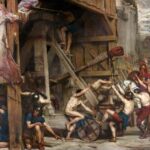In most studies, the equipment of Roman legionary is discussed in terms of armament, and less attention is paid to items that facilitated everyday life in camps and forts or those that were useful in the art of survival. An extremely important element of the professional equipment of a Roman legionary was the so-called dolabra.
The tool was a combination of an axe and something like a pickaxe. The heads of dolabrae were very similar to, for example, the heads of today’s fire axes. One of the primary uses of the dolabra was camp work, such as preparing firewood, and construction work, such as building field fortifications and bridges. Such a tool was certainly suitable for opening the doors of houses in which the enemy was barricaded, or for damaging the enemy’s fortifications to some extent. We also know that the dolabra could be useful in close combat. In the battle of Augustodunum, the legionaries successfully repelled the heavily armed gladiators crupellarius with the help of dolabrae.
What could the role of this tool look like in survival, i.e. in the art of survival? Disappearance, the need to survive in isolation from your unit, digging out of the battlefield alive after the defeat … Such situations in the army of the Roman Empire certainly happened to many legionarys. In this matter, the environment in which the legionary was located was of fundamental importance. As in the dark forests of Germania and Dacia carrying such a tool made sense (preparing firewood, building a shelter), in the deserts of Syria and Mesopotamia, it would be simply unnecessary ballast. Finally, I will add that the dolabra was a tool of considerable dimensions and did not resemble light camping hatchets. In the art of survival, it is important not only to ration water and food, but also to energy efficiency, and having too heavy equipment is not conducive to it.






